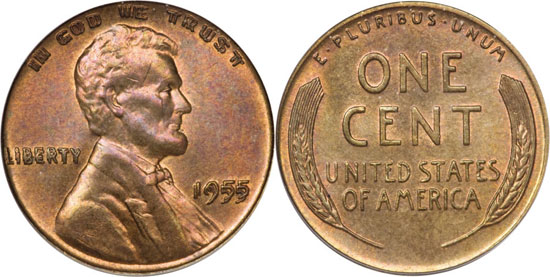Background and History
The 1955 Doubled Die Lincoln Cent (Buy on eBay) is a famous and popular die variety of the Lincoln Cent series. Struck from a single die pair during a single day, it is one of the most strongly doubled dies to have occurred within American numismatics. The doubling on the obverse lettering is plainly visible even without magnification. Due to the limited number of examples struck and the dramatic appearance, examples are highly valued and eagerly sought by collectors.

Doubled Dies are essentially Mint mistakes that occur during the process of creating the working dies necessary to strike coins. In the typical process, the working hub, which contains raised design elements, is pressed against heated blank dies to place the incuse image onto the dies. To make sure all of the details are properly transferred, multiple impressions of the hub against the die are necessary. If the hub becomes misaligned between impressions, some or all of the lettering and devices on the die will appear doubled. This doubling will transfer to all coins struck by the impacted die. In some cases, the doubling will be minimal and only noticeable under magnification. In other cases, such as the 1955 Doubled Die Lincoln Cent, the doubling is easily recognizable due to the significant shift between the impressions of the working die.
The 1955 Doubled Die Cents were produced during a period when there was a shortage of circulating cents and the Mint was having difficulty keeping up with demand. On the day the variety was produced, several presses were striking cents which were all dumped into a single box. A mint inspector had noticed the unusual appearance of some of the cents mixed into the box, but chose to take no action since it was deemed impractical to melt the entire box due to a small number of defective pieces. Thus, the doubled die cents were released into circulation.
During the next few months, the doubled dies turned up across the Atlantic seaboard, with the first example discovered in Massachusetts in the fall of 1955. Cigarette packs purchased from vending machines would emerge as a primary source for the coin. At the time, the packs costs 23 cents, but the machines that dispensed them could not refund change so two cents were pasted on or placed inside the pack. It was here that many of the doubled die examples were discovered.
Coin Mintage
It is generally assumed that all 1955 Doubled Die Lincoln Cents were produced during a single day at the Philadelphia Mint. According to most sources, approximately 20,000 to 24,000 of the 1955 Doubled Die Lincoln Cents were released into circulation within a batch of approximately 10 million newly struck coins. This was still just a small fraction of the total mintage of Philadelphia cents for the year, which reached 330 million pieces. This represented a relatively high number, but only about half of the highest mintage that was achieved during the decade.
From the original mintage of doubled die cents, only a portion have survived for later generations of collectors. Since nearly the entire mintage went into circulation, it can be practically assumed that many were lost over the course of the months and years following their mintage. Based on auction appearances and the general availability of the issue, modern sources usually quote approximately 12,000 to 15,000 examples believed to exist across all grades. The available supply has been met with constant demand from collectors. Most examples that come on the market are quickly bought and placed into collections where they often remain for many years.
Finest Known and Values
The circumstances surrounding the release of the 1955 Doubled Die Lincoln Cent result in a scarcity of surviving examples in gem condition, particularly with original Mint red coloration. Since basically all examples were released into the channels of circulation, coins had to be retracted by the conscientious public, often after receiving some wear. The scarcity of examples with original red coloration is due in part to the original distribution of many pieces within cigarette packs, which contained chemicals that tended to tone freshly minted copper coins.
The finest known Red examples that have been certified by PCGS are 21 MS-65 RD’s, a number which appears to be at least slightly influenced by resubmissions. This is the process by which the same coin is submitted to the grading service multiple times in an attempt to receive a more favorable grade. MS-64 RD’s are more available, with 175 examples graded by PCGS, but perhaps only 100 examples really exist, with the others being resubmissions as well. NGC, the other major grading service, has graded a single example as MS-66 RD, the absolute finest known. Additionally, three examples have been graded in MS-65 RD by that company.
In Red-Brown, PCGS has graded 10 examples in MS-65 RB, with more than 200 in MS-64 RB. These are not as difficult to find as Red examples but remain sufficiently scarce. NGC has graded a single MS-66 RB, with an additional 15 MS-65 RB’s and more than 200 in MS-64 RB.
In Brown, the most available color designation for this popular variety, PCGS has graded a single MS-66 BN, with a dozen MS-65 BN’s. NGC shows a population of 15 MS-65 BN’s. Most uncirculated 1955 Doubled Die Lincoln Cents are graded MS-62 BN or MS-63 BN, with populations in the hundreds at each of the grading services.
The finest known example, graded MS-66 RD by NGC, sold for $50,019 in 2006. Examples graded PCGS MS-65 RD have topped this amount, with one selling for $59,225 back in 2001. The auction record for the issue is for an example graded PCGS MS-65+ RD, which sold for $114,000 in 2018. Red-Brown and Brown designated examples are more available, although gem Red-Brown examples still carry a price tag of approximately $15,000 or more. Nice circulated examples of the coin are relatively more affordable, with quality examples available for around $2,000.

